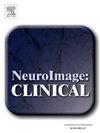Evidence for temporal disintegration of information processing during sensorimotor integration in GTS
IF 3.6
2区 医学
Q2 NEUROIMAGING
引用次数: 0
Abstract
In Gilles de la Tourette syndrome (GTS), a neuropsychiatric disorder defined by the presence of tics, bindings of perceptual and motor processes in what cognitive theories refer to as event files is altered. The neural basis of such abnormal coupling though is currently unclear, particularly as regards oscillatory activity in theta, alpha, and beta frequency bands. The inter-relation between oscillatory activities in the theta, but also the alpha and beta band during event file binding and retrieval was investigated in the present study in patients with GTS and healthy controls (HC) using a well-established stimulus–response event file task and concomitant EEG recording. Behaviorally, binding effects did not differ between groups. Also, there were well-known patterns of theta, alpha and beta band activity during retrieval in both groups. In addition, corroborating previous findings in HC, in the period after event file binding and before retrieval, theta, alpha and beta band activity was found in the insula cortex, inferior/middle frontal and superior/middle temporal areas of the right hemisphere in both groups. However, in comparison to HC, GTS patients exhibited relatively less widespread oscillatory correlations between the post-binding and retrieval periods. Notably, a correlation between beta-band oscillations in the supplementary motor area (SMA) and oscillatory activity during the post-binding period was observed only in HC, but not in GTS. This absence in GTS may reflect a disrupted management of event files following retrieval. Overall, the findings suggest a relative decoupling of oscillatory activity associated with binding and retrieval processes in individuals with GTS.
GTS中感觉运动整合过程中信息加工时间解体的证据
抽动症(Gilles de la Tourette syndrome, GTS)是一种神经精神疾病,其特征是抽搐,认知理论所称的事件文件中知觉和运动过程的绑定发生了改变。然而,这种异常耦合的神经基础目前尚不清楚,特别是关于θ、α和β频段的振荡活动。本研究在GTS患者和健康对照(HC)中,采用完善的刺激-反应事件文件任务和伴随的脑电图记录,研究了事件文件绑定和检索过程中θ波、α和β波振荡活动之间的相互关系。在行为上,两组之间的结合效果没有差异。此外,两组在检索过程中都有众所周知的θ、α和β波段活动模式。此外,在事件文件绑定后和检索前,两组的脑岛皮层、额下/中区和右半球颞上/中区均有θ、α和β带活动,这与先前的HC研究结果相印证。然而,与HC相比,GTS患者在结合后和恢复周期之间表现出相对较少的振荡相关性。值得注意的是,仅在HC中观察到辅助运动区(SMA)的β带振荡与结合后时期的振荡活性之间的相关性,而在GTS中则没有。GTS中的这种缺失可能反映了在检索之后对事件文件的中断管理。总的来说,研究结果表明,与GTS个体的结合和恢复过程相关的振荡活动相对解耦。
本文章由计算机程序翻译,如有差异,请以英文原文为准。
求助全文
约1分钟内获得全文
求助全文
来源期刊

Neuroimage-Clinical
NEUROIMAGING-
CiteScore
7.50
自引率
4.80%
发文量
368
审稿时长
52 days
期刊介绍:
NeuroImage: Clinical, a journal of diseases, disorders and syndromes involving the Nervous System, provides a vehicle for communicating important advances in the study of abnormal structure-function relationships of the human nervous system based on imaging.
The focus of NeuroImage: Clinical is on defining changes to the brain associated with primary neurologic and psychiatric diseases and disorders of the nervous system as well as behavioral syndromes and developmental conditions. The main criterion for judging papers is the extent of scientific advancement in the understanding of the pathophysiologic mechanisms of diseases and disorders, in identification of functional models that link clinical signs and symptoms with brain function and in the creation of image based tools applicable to a broad range of clinical needs including diagnosis, monitoring and tracking of illness, predicting therapeutic response and development of new treatments. Papers dealing with structure and function in animal models will also be considered if they reveal mechanisms that can be readily translated to human conditions.
 求助内容:
求助内容: 应助结果提醒方式:
应助结果提醒方式:


